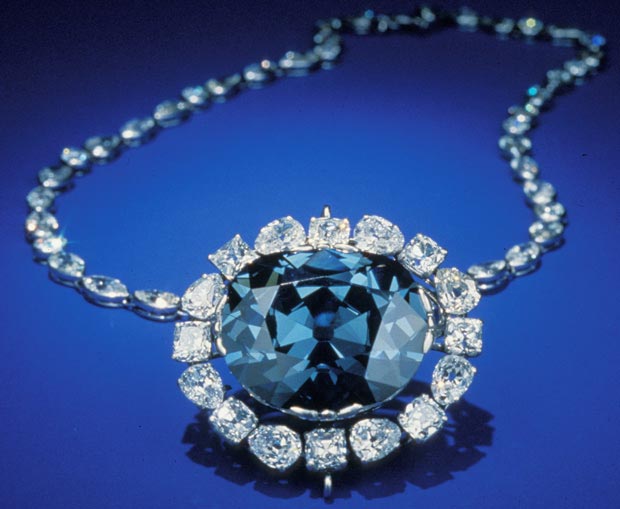Lord Shiva and the Hope Diamond
By Angela Sirnik | Oct 11, 2008

It is said that India has the most beautiful diamonds in the world. History has proven the magnificent glory of diamonds and their influence. Kings wore them to signify wealth and power. They also decorated their palaces and living quarters with them. Indian physicians believed that the stones could lower fevers if placed on the forehead, cure pains when placed on the stomach, ward off mania when clutched in the right hand, and produce a toughness in the body to match its own. The Ratnapariska of Buddhabhatta, a Sanskrit manual on gems dating from about A.D. 500, states: “He who wears a diamond will see dangers recede from him, whether he be threatened by serpents, fire, poison, sickness, thieves, flood or evil spirits.”
Somewhere between one billion and five hundred million years ago, the famous Hope Diamond made its long and perilous journey from darkness under the ground to light. The Hope Diamond is reported to have first surfaced in the Deccan area, later called the Kingdom of Golconda, near the mighty Krishna River, which empties into the Bay of Bengal on the east coast. Most of India’s largest diamonds, and all its colored ones, have been found in this region.
The Hope Diamond was first discovered as late as the 1650s. While it stayed in India, other diamonds were loaded onto boats and rowed west by galley slaves across the Arabian Sea. They were then packed onto camels’ backs for the long desert trek overland to a trading center at Ormus, before fanning out to Persia, Arabia, and Turkey, and entering Europe via a second trade market at Constantinople. Some of the traveling diamonds reached the Greeks – who called them adamant, or “unconquerable,” – as early as the fifth century B.C. The Greeks believed stones were living beings, and divided them into male and female.
The diamonds that were being praised and promoted abroad, however, weren’t the largest stones; those stayed in India, claimed by its rulers to ensure a long reign and victory on the battlefield. Diamonds were not only mined and valued, but also taxed to augment a king’s revenues and traded with other countries. Not because they possessed beauty – for the rough, uncut stones had little – but because they had such purported supernatural powers. Several Sanskrit texts suggest that blue diamonds – such as the Hope Diamond – carried a potent curse.
At least four chroniclers of the Hope Diamond’s history write that it once served as the middle eye of a South Indian deity of Lord Shiva. This deity belonged to the Chola dynasty, who ruled in South India from about A.D. 850, and revered Shiva as Nataraja, Lord of Dance. The Chola’s sculptor was trained in the workshop of a master, where he’d learned the ancient scriptural formulas for making a deity.
At some point, the sculptor must have unwrapped the beautiful blue Hope Diamond and placed it into the hollow area in the middle of Lord Shiva’s forehead. It is said Lord Shiva’s two eyes symbolized the sun and moon; the third eye was fire, enabling Him to create or destroy, to bless or to curse, and to see in wondrous ways.
This eye was later pried out under very questionable circumstances. The deity of Lord Shiva would be carried in a procession to the temple’s innermost shrine, where priests performed the ceremony of giving Him prana, the breath of life.
Seeing and being seen by the deity is called darshan. The worshiper sees the deity but the deity also sees the worshiper. On holy days, worshipers came from miles around, cleansed themselves in the large water tank beside the temple, and entered Siva’s dark shrine. In silent, private meditation, they focused on the huge blue eye, feeling its life force. But then came a horrible time when an unknown hand pried the beautiful blue diamond loose and stuffed it into the blindness of a small purse.
From then on, the Hope Diamond carried an omen of curses to whomever came to purchase it. It would travel through time, leaving India and making its way to the hands of various greedy owners. Some wanted to sell it for profit, and some wanted to posses it for its beauty. But little did they know that the powerful third eye of Lord Shiva carried a big price for its ownership. Throughout history, death and unfortunate circumstances have befallen the owners of the Hope Diamond. Still, the Hope has never been returned.
It is most unfortunate that the Hope Diamond has made its home in the United States, where it can be seen at the Smithsonian in Washington D.C. There it sits and shines in all of its blue brilliance, power and abundance, waiting to be returned to its original owner – Lord Shiva.















